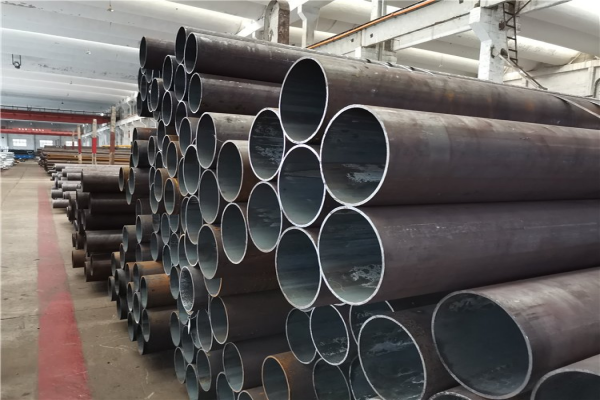ASTM A106 - Standard Specification for Seamless Carbon Steel Pipe for High Temperature Service
ASTM A106 seamless steel pipe (also known as ASME SA106 pipe) is a United States standard steel pipe.
What is the ASTM A106 standard?
This specification covers carbon steel pipe for high temperature service. These pipes are suitable for welding, bending, flanging, and similar forming operations. Mechanical tests on the specimens shall include tensile, bending, flattening, hydrostatic, and nondestructive electrical tests. Specimens for bend tests shall consist of sections cut from the pipe. For flattening tests, the ends of the specimens shall be smooth and free of burrs unless performed on cut ends. All tests shall be conducted at room temperature. If any specimen develops a defect, it may be discarded and replaced with another specimen. Retesting shall be permitted if the specimen is scratched before testing. Retesting shall also be permitted if the specimen breaks at an inner or outer surface defect.
What are the applications of ASTM A106 seamless casrbon steel pipe?
For ASTM A106 seamless casrbon steel pipe, which can transport fluids or gases at high temperature and high pressure levels, there are 3 grades A, B, C, and the most commonly used ASTM A106 Grade B is widely used in oil and gas refineries, power plants, petrochemical plants, boiler projects.
What is ASTM A106 seamless casrbon steel pipe?
ASTM A106 seamless pipe is also called ASME SA106 pipe, which usually refers to a pipe with seamless structure, mainly used to transport gas and liquid from one place to another, ASTM A106 pipe is best suited for high temperature services and can withstand a lot of pressure. These pipes are manufactured as per the dimensional standards of ANSI B36.10 / ASME B36.10. Among ASTM A106, Grade B is the most commonly used pipe, and this grade is the first choice of customers due to its economical price and easy availability around the world.
The minimum yield strength for B-grade pipe is 240 MPa, the minimum yield strength for C-grade pipe is 275 MPa, the minimum tensile strength for B-grade pipe is 415 MPa, the minimum tensile strength for C-grade pipe is 485 MPa, and the minimum elongation is 16.5%/30%.
The pipes are manufactured by cold-drawn finishing process or hot-working process. Cold-drawn finishing pipes need to be heat-treated at 900 degrees Celsius for normalizing. These pipes are mainly used in oil and gas refineries, petrochemical plants, boilers, chemical plants, shipbuilding and other industries.

Reference standard of ASTM A106 specification
ASTM A 530/A 530M Specification for General Requirements for Specialized Carbon and Alloy Steel Pipe.
ASMT E 213 Practice for Ultrasonic Examination of Metal Pipe and Tubing.
ASTM E 309 Practice for Eddy-Current Examination of Steel Tubular Products Using Magnetic Saturation.
ASMT E 381 Method of Macroetch Testing Steel Bars, Billets, Blooms, and Forgings.
ASTM E 570 Practice for Flux Leakage Examination of Ferromagnetic Steel Tubular Products.
ASME B36.10M Dimension standard for Seamless and Welded pipes.
Chemical Composition of ASTM A106 pipes
|
|
Grade A
|
Grade B
|
Grade C
|
|
Carbon max. %
|
0.25
|
0.30*
|
0.35*
|
|
Manganese %
|
0.27 to 0.93
|
*0.29 to 1.06
|
*0.29 to 1.06
|
|
Phosphorous, max. %
|
0.035
|
0.035
|
0.035
|
|
Sulfur, max. %
|
0.035
|
0.035
|
0.035
|
|
Silicon, min. %
|
0.10
|
0.10
|
0.10
|
|
Chrome, max. %
|
0.40
|
0.40
|
0.40
|
|
Copper, max. %
|
0.40
|
0.40
|
0.40
|
|
Molybdenum, max. %
|
0.15
|
0.15
|
0.15
|
|
Nickel, max. %
|
0.40
|
0.40
|
0.40
|
|
Vanadium, max. %
|
0.08
|
0.08
|
0.08
|
* Unless otherwise specified by the purchaser, for each reduction of 0.01% below the specified carbon maximum, an increase of 0.06% manganese above the specified maximum will be permitted up to a maximum of 1.65% (1.35% for ASME SA106).
A106 steel pipe testing requirements
Hydrostatic test: In the hydrostatic test, the A106
seamless steel pipe sample is subjected to a test pressure of 60% of the specified minimum yield strength at ambient temperature; the pressure test is maintained for at least five seconds. The maximum test pressure of NPS3 steel pipe shall not exceed 2,500 psi, and the maximum test pressure of all larger sizes of steel pipe shall not exceed 2,800 psi.
Mechanical Testing: A106 seamless pipes NPS 8 and above are weighed by batch; larger sizes are weighed by length. A106 pipes NPS 2-1/2 and above require a flattening test; A106 pipes NPS 2 and below require a cold bend test.
Baowi-steel stocks A106 seamless pipes, also known as A106 seamless pressure pipes, in a variety of sizes and profiles. This pipe is typically used in pipelines that transport fluids and gases at high temperatures and/or high pressures. A106 seamless pressure pipes are key components in power plants, oil and gas refineries, petrochemical processing plants, boilers, and more.
Request a quote or contact
Baowi-steel for more information on A106 steel pipes.






 English
English Español
Español بالعربية
بالعربية











 Phone :
Phone :  Whatsapp :
Whatsapp :  Email :
Email : 


